
Sonnet 38 is one of 154 sonnets written by the English playwright and poet William Shakespeare. It is a member of the Fair Youth sequence, in which the lyric subject expresses its love towards a young man.

Sonnet 48 is one of 154 sonnets written by the English playwright and poet William Shakespeare. It is a member of the Fair Youth sequence, in which the poet expresses his love towards a young man.

Sonnet 49 is one of 154 sonnets written by the English playwright and poet William Shakespeare. It is a member of the Fair Youth sequence, in which the poet expresses his love towards a young man.

Sonnet 50 is one of 154 sonnets written by the English playwright and poet William Shakespeare. It is a member of the Fair Youth sequence, in which the poet expresses his love towards a young man. It is continued in Sonnet 51.

Sonnet 51 is one of 154 sonnets written by the English playwright and poet William Shakespeare. It is part of the Fair Youth sequence, in which the poet expresses his love towards a young man. It is a continuation of the argument from Sonnet 50.
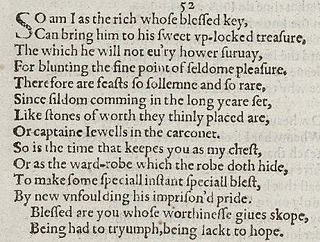
Sonnet 52 is one of 154 sonnets written by the English playwright and poet William Shakespeare. It is a member of the Fair Youth sequence, in which the poet expresses his love towards a young man.
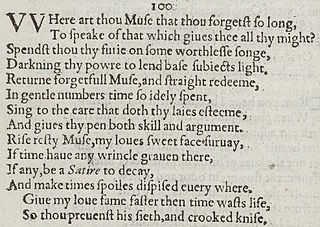
Sonnet 100 is one of 154 sonnets written by the English playwright and poet William Shakespeare. It is a member of the Fair Youth sequence, in which the poet expresses his love towards a young man.

Sonnet 91 is one of 154 sonnets written by the English playwright and poet William Shakespeare. It's a member of the Fair Youth sequence, in which the poet expresses his love towards a young man.
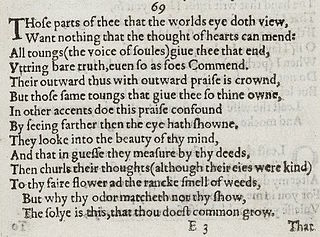
Shakespeare's Sonnet 69, like many of those nearby in the sequence, expresses extremes of feelings about the beloved subject, who is presented as at once superlative in every way and treacherous or disloyal.
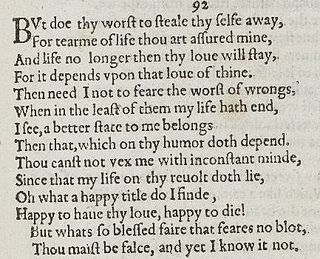
Sonnet 92 is one of 154 sonnets written by the English playwright and poet William Shakespeare. It is a member of the Fair Youth sequence, in which the poet expresses his love towards a young man.
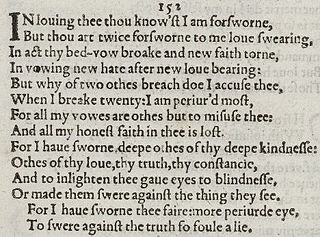
Sonnet 152 is a sonnet by William Shakespeare. It is one of a collection of 154 sonnets, dealing with themes such as the passage of time, love, beauty and mortality, first published in a 1609.

Sonnet 150 is one of 154 sonnets written by the English playwright and poet William Shakespeare. It is considered a Dark Lady sonnet, as are all from 127 to 152. Nonetheless 150 is an outlier, and in some ways appears to belong more to the Fair Youth.
Sonnet 149 is one of 154 sonnets written by the English playwright and poet William Shakespeare.

Sonnet 148 is one of 154 sonnets written by the English playwright and poet William Shakespeare.
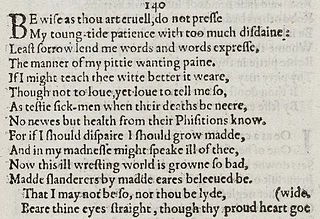
Sonnet 140 is one of 154 sonnets written by the English playwright and poet William Shakespeare. Sonnet 140 is one of the Dark Lady sonnets, in which the poet writes to a mysterious woman who rivals the Fair Youth for the poet's affection.

Sonnet 139 is one of 154 sonnets written by the English playwright and poet William Shakespeare.

Sonnet 131 is a sonnet written by William Shakespeare and was first published in a 1609 quarto edition titled Shakespeare's sonnets. It is a part of the Dark Lady sequence, which are addressed to an unknown woman usually assumed to possess a dark complexion.

Sonnet 95 is one of 154 sonnets written by the English playwright and poet William Shakespeare. It is a member of the Fair Youth sequence, in which the poet expresses his love towards a young man.
Sonnet 120 is one of 154 sonnets written by the English playwright and poet William Shakespeare. It's a member of the Fair Youth sequence, in which the poet expresses his love towards a young man.

Shakespeare's sonnet 117 was first published in 1609. It uses similar imagery to Sonnet 116 and expands on the challenge in the closing couplet. Using legally resonant metaphors, the poet defends himself against accusations of ingratitude and infidelity by saying that he was merely testing the constancy of those same things in his friend.




















